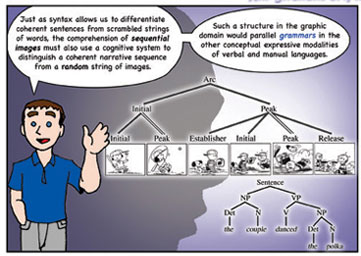Syntax, narrative, grammar… what!?
One of the aspects of my theories that people often find confusing is my claim that sequential images use a “narrative grammar” that is analogous to the grammar in sentences. This is confusing to many, because clearly individual images hold much more information than individual words.
This is true, but the analogy I make cuts beyond merely how much information is being conveyed, and involves deeper aspects of cognition related to their function, structure, and processing.
At the level of information, yes, panels contain much more information than words: they contain information more analogous to whole sentences. In fact, I would argue that the “narrative structure” that guides sequential images is the same structure that guides discourse and narrative of verbal stories. My theory works equally well for both of them.
So, why is there an analogy between narrative and syntax then?
First, though sequential images convey more information than individual words, narrative structure serves the same function as syntax to the communicative system.
Both syntax and narrative function to package meaning in ways that are linear and coherent. Syntax itself is not meaning. The sentence Paul kissed Samantha is the same in meaning as Samantha was kissed by Paul, though they have different syntactic structures. Similarly, the same meaning can be conveyed in multiple ways in a sequence of images. These are the “storytelling” choices that authors make. “Narrative grammar” is the system that describes these rules.
Second, these rules governing narrative are structured in similar ways to syntax.
There are two main aspects of this analogy. Both syntax and narrative use “grammatical categories” that provide functional roles to their units. In syntax, these categories are nouns and verbs. However, the categories for sequential images are not nouns and verbs, but rather things that I call Establishers, Initials, Peaks, Releases, etc. These categories are determined both through aspects of their meaning, but also through the ways in which they appear throughout a sequence—their “distributional trends.”
Also similar to syntax, narrative is organize into hierarchic groupings. Just as syntax cannot simply move from “transitions” between one word and the next, sequential images are not understood by linear relationships between juxtaposed images. You need to be able to create groupings of images, and connect panels together across non-juxtaposed distances (such as in the above example excerpted from Tym Godek’s One Night). In both syntax and narrative, these groupings then create several other constraints related to resolving ambiguity, making distance connections, coordinating the order of segments, etc.
Thus, the architecture of the “grammars” of both syntax and narrative are built in similar ways.
Third, the processing of narrative structure appears to be similar to the processing of syntax in the brain.
While this research is new and ongoing, the results so far from experiments on the comprehension of sequential images suggest that the same brain responses occur for the processing of narrative grammar as syntax (see here and here). In my experiments, I have tried to replicate the methods of classic experiments on sentence structure, and I have found similar results as these studies (short versions: here and here).
Now, does the fact that the same brainwave effects occur to syntax and narrative mean that the “same grammar” is being used in both? No. This does not mean that sequential images use the syntax of nouns and verbs. Rather, it means that the brain is treating both of these systems—these grammars—in similar ways.
For more information about my theories of Visual Narrative Grammar, check out my new book, The Visual Language of Comics, and in downloadable papers on my website.


Comments